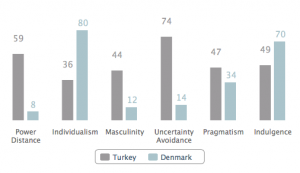Choosing Foreign Markets in the Software Industry – 4
This series of posts discusses how to choose foreign markets in the software industry.
Links to previous posts in this series are listed at the end of this post.
Entering a foreign market in the software industry is a very strategic decision. Finding, winning, making, keeping and growing customers in foreign countries requires establishing infrastructures, which can drive the marketing and sales processes as well as the implementation and support activities. Customers in foreign markets will be reluctant to do business with us unless we can demonstrate a solid commitment for the long haul.
A competitive product is not enough.
Culture
The top 25 markets are spread all over the world, representing at least 15 different languages and are located in very different cultures.
Measuring culture characteristics and assessing which challenges they will represent are obviously very difficult.
Culture plays an important role in how we can undertake the tactical implementation of our business models. The further away from our cultural origin we come the more we will have to listen to and rely on local people or people who have specific cultural insight.
There are two sources for cultural insight that I will mention here.
The World Value Survey
The World Value Survey measures, monitors and analyzes: “Support for democracy, tolerance of foreigners and ethnic minorities, support for gender equality, the role of religion and changing levels of religiosity, the impact of globalization, attitudes toward the environment, work, family, politics, national identity, culture, diversity, insecurity, and subjective well-being.” The World Value Survey produces the map shown in Figure 1.
The Hofstede Centre
The Hofstede Centre provides a very practical service comparing various cultures and countries with each other on the following dimensions:
- Power distance
- Individualism
- Masculinity
- Uncertainty avoidance
- Pragmatism
- Indulgence
An example of a Hofstede comparison is illustrated in Figure 2. The differences between cultures are substantial and values can be directly reversed from one culture to another. Although most business models will work in most cultures (business is business) the tactical implementation can be very different. Ignoring cultural differences in the tactical implementation can make business models that are successful in one country fail completely in another country.
Previous posts in this series:
Choosing Foreign Markets in the Software Industry – 1
Choosing Foreign Markets in the Software Industry – 2
Choosing Foreign Markets in the Software Industry – 3
Choosing Foreign Markets in the Software Industry – 5










